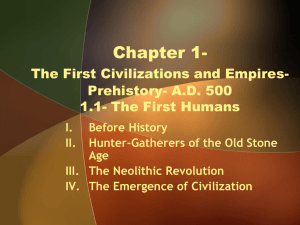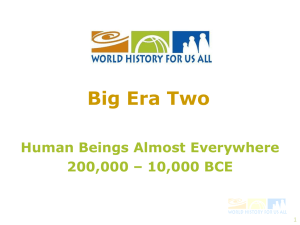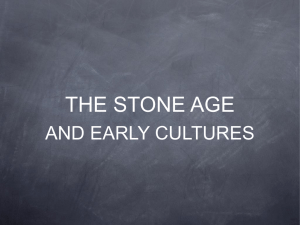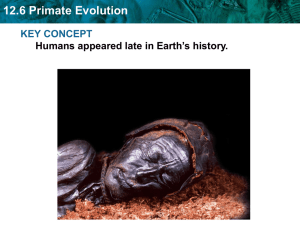homohabalec-chris-jenni-and-talia
advertisement
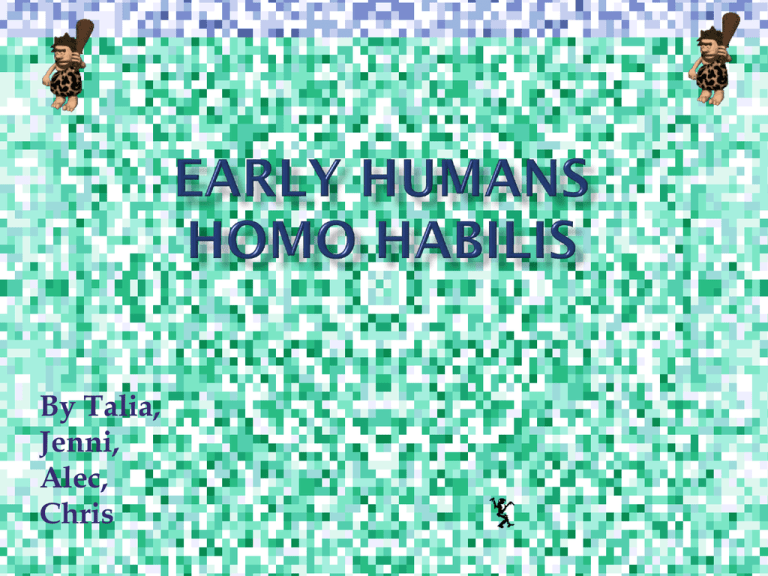
By Talia, Jenni, Alec, Chris The Homo Habilis lived at the time period of two million B.C. They lived in Africa. The Homo Habilis finally died out in the time period of about one point five million years ago. [1] The Homo Habilis were about four point five feet tall . Their faces looked more like ours than Australopithecus . The Homo Habilis had the largest brains of their time . They had small teeth that were good for eating meat. [2] The Homo Habilis had simple huts. These huts were dome- shaped and were made from branches. These huts protected the Homo Habilis from wind, rain, and wild animals. The branches were held up by rocks.[3] The Homo Habilis ate small animals, bird eggs, and small plants. They ate their food raw because they didn’t know how to make fire. [4]After they killed the animals, they would smash open the bones and eat the bone marrow inside.[5] Homo Habilis moved a lot. They didn’t stay in one place for too long. They hunted and ate their food raw. They also gathered food like roots, berries, herbs, bird eggs, and more. They also might have worked on tools for hunting during the day. They didn’t really have a daily life except for hunting and working on tools.[6] Homo Habilis didn’t have sophisticated weapons to hunt, but they hunted in large groups.[7] After their prey was down, they killed it with sticks and stones at the catch site.[8] At the kill site, they would sharpen one stone with another and then cut it open. After they got their share of the meat, they would smash open the bones for the marrow.[9] The Homo Habilis had fire.[10] They didn’t know how to make it . They didn’t always have to eat their food raw if they found fire. They had fire after lightning storms and forest fires.[11] The Homo Habilis didn’t have any types of religion at all. Homo Habilis were still in the stone age and couldn’t communicate enough to have any type of religion . They were also too busy with survival for things such as religion. [12] Homo Habilis didn’t have any type of language, so they used simple gestures. They also used simple sounds. The simple sounds might have been grunts or growls.[13] Homo Habilis didn’t have any types of clothing. They did have hair all over their bodies. Their hair helped keep them warm. They also had shelters. The shelters helped protect them from rain, wind, and maybe even hail storms.[14] The Homo Habilis didn’t do any type of paintings. In fact, they didn’t even have the correct tools to paint. Although the Homo Habilis first used tools , this doesn't mean they had the correct tools. [15] Homo Habilis were also called handy man. They were the first true humans because they had shorter arms, less hair, and could actually make tools, not just use what they found as tools. They had increased height since the Austrolapithicus . They also had increased intelligence . They lived in the beginning of the Stone Age. Their brain was half of the size of the modern humans.[16] The Homo Habilis had a nick name in a different language. How did they get their nickname? Name three things the Homo Habilis did not or could not have. What were the Homo Habilis’s homes made of and what were three things that these homes protected them from?. Their nickname is “handy man,” which is Homo Habilis in Latin. Three possible answers are as follows: fire, clothing, written language. Their houses were made of sticks and stones, and they protected them from rain, wind, snow, and animals. The Homo Habilis were great early humans because they were some of the first true humans. They were the first to make tools. They had the biggest brains of their time. They also looked the most like us from their time. They had smaller teeth than the Austrolapithicus, and their teeth were good for eating meat. They had simple, but strong, buildings. We hope that you had a great time learning about this group of tool-makers. 1. 2. 3. 4. 5. 6. 7. 8. 9. 10. 11. 12. 13. 14. 15. 16. California Visits Ancient Civilizations. Macmillan/MacGraw Hill: New York, NY, 2007, p. 72 Kearns, Marsha, “Homo Habilis,” Early Humans, Creative Teaching Press, CA, 1993, p. 4. Ibid. Ibid. MacMillan/MacGraw Hill, p. 74. Kearns, “Homo Habilis,” p. 4. Ibid. Ibid. Ibid. “Early Humans,” www.earlyhumans.mrdonn.org/tools.html. Ibid. Ibid. MacMillan/MacGraw Hill, p. 74. Kearns, “Homo Habilis,” p. 4. Ibid. Facchini, Fiorenzo, “A Day with Homo Habilis, Twenty-First Century Books, CT, 2003, p. 24. California Visits Ancient Civilizations. Macmillan/MacGraw Hill: New York, NY, 2007. Facchini, Fiorenzo. “A Day with Homo Habilis.Twenty-First Century Books: CT, 2003. “Homo habilis.” Homo habilis. http://www.earlyhumans.mrdonn.org/. Kearns, Marsha.“Homo Habilis.” Early Humans. Creative Teaching Press: CA, 1993. We’d like to give a special thanks to : Mr. Donn’s Early Humans for Kids - Handy Man, the First Tool-Makers, the early humans packet, the history book, and To Mrs. McClure






